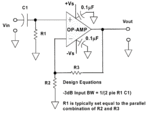matrixon
Junior Member level 1
I've heard that a DC path is needed
at the input of an op amp,or the op amp
won't be functional because there is no
path for the input bias current.
(in the image below,R1 provides a dc
path for input bias current)

But if I use MOSFETs to design an op amp,is there still input bias current(the gate of MOSFETs have no current)?Or do I still need to add R1 to make op amp functional?
at the input of an op amp,or the op amp
won't be functional because there is no
path for the input bias current.
(in the image below,R1 provides a dc
path for input bias current)

But if I use MOSFETs to design an op amp,is there still input bias current(the gate of MOSFETs have no current)?Or do I still need to add R1 to make op amp functional?